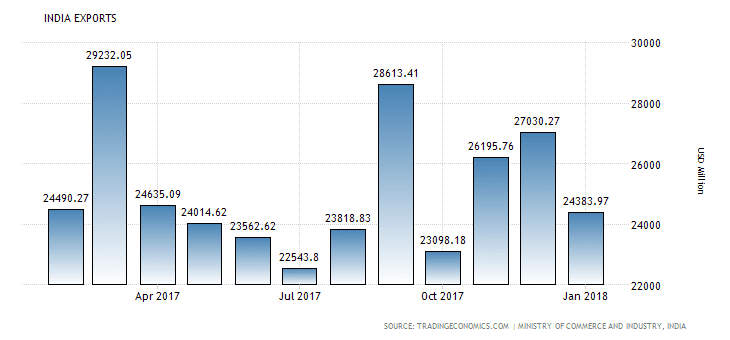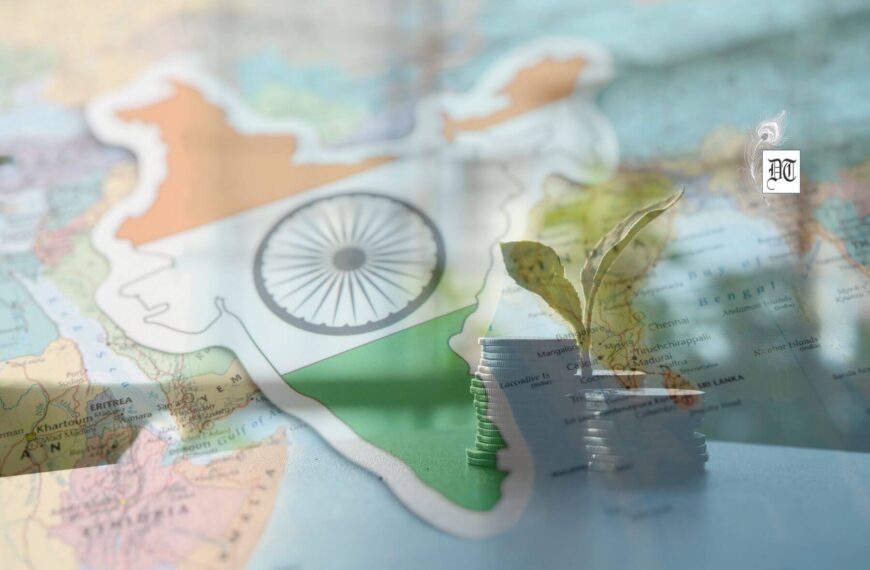India missed the bus in early 2000 when it had an opportunity to become a global hub for manufacturing as well as services. India’s share in goods exports was less than 2 percent in world exports as against China’s nearly 14 percent. But in services exports, our performance is slightly better at around 3.5 percent of world exports. Today there is yet another opportunity for India to become a global exports hub if only the right policy is put in place to push both goods and services exports through big-ticket reforms. Here’s an analysis, for Different Truths.
Widening trade deficit to a 65-month high at $16.3 billion in January this year has raised eyebrows, that too at a time when India’s exports have started looking up somewhat in recent quarters after a poor showing the last couple of years. This is because of the surge in imports of crude oil and precious stones. Global oil prices have started increasing lately and it is not clear where it is going stabilise. The trade deficit might have expanded much faster this year than last year but the fact of the matter is that this is the right time for India to start big ticket exports reform so that the country can play a significant role in world trade.
India missed the bus in early 2000 when it had an opportunity to become a global hub for manufacturing as well as services. India’s share in goods exports was less than 2 percent in world exports as against China’s nearly 14 percent. But in services exports, our performance is slightly better at around 3.5 percent of world exports. Today there is yet another opportunity for India to become a global exports hub if only the right policy is put in place to push both goods and services exports through big-ticket reforms. After global trade being in the negative territory, growing less than the world GDP growth, it has started looking up, growing rapidly at 4.7 percent this financial year. According to International Monetary Fund, global trade is expected to grow impressively at around 4.6 percent in the next couple of years. The time is ripe for India to cash in. After exports growth being in negative territory, it has started looking up, growing at 9-10 percent this financial year even though there is a small blip in January.
H A C Prasad, who until recently was principle economic advisor in the finance ministry, has come out with two separate studies on the challenges and policy initiatives needed to take India’s goods and services exports to a new high.
Prasad, who was an earlier economic advisor in the commerce ministry, is of the view that there are green shoots in India’s merchandise exports that is goods exports. So it is only appropriate to raise India’s share in world exports to a respectable five percent. For this India’s goods exports should reach $882 billion by 2020, which means export growth rate needs to be around 27 percent CAGR in five years. This is not impossible as India has had higher exports growth than this during 2004-09.
Service exports, which had gone from $53 billion in 2005 to $162 billion annually in 2016, has done better than the goods exports growth in the first half of 2017-18 at 16.2 percent. Various initiatives have already been taken by the government to push services exports but more needed to be done now that the ill-effects of demonetisation and rollout of Goods and Services Tax are now behind us.
Prasad is of the view that India’s goods exports have to be first made demand-based rather than supply-based as at present and with regard to services exports, there is a need for ‘services from India’ initiative just as the Make in India initiative to promote manufacturing exports.
In world trade, the presence of India’s exports was very small. In 2015, India’s exports share in the top 100 items was not that impressive and only in 5 of those items the share was more than 5 percent. That’s why there is a need for making our exports demand-based rather than supply-based. Likewise, there is a need for rationalising tariffs. Though the average customs duty is around 10 percent, the real applied duty is around 2.8 percent because of various exemptions provided. This is creating distortions. However, the recent hike in customs duty in some of the electronics items in the budget is warranted to promote Make in India programme. This has also helped in reversing the inverted pyramid customs duty structure that was hindering domestic manufacturing.
On Ease of Doing Business, though India has moved up in the global ranking, it has still a long way to go. India is still much behind many ASEAN countries in trading across borders. Some specific steps were needed. Though there are claims of single window customs clearance for exporters, there are still hurdles which need to be rectified. India is the cheapest and largest manufacturer of agro products, particularly fruits and vegetables and yet India’s share in global exports is very low. This is one area where the government has come out with out of the box initiatives so that India becomes not only a major exporter but also can address livelihood concern of the farmers. There is also need to create an ombudsman for resolving exports related problems and disputes. Presently there is no clear-cut mechanism apart from being bureaucratic.
On promoting services exports, Prasad points out that there was a need for reforms in domestic regulations so that it is conducive for services exports rather than erecting restrictive trade barriers. There are many market access trade barriers in India’s trading partner countries, which include visa issues, shipping, licensing of professional services and so on. There is also tremendous potential for disinvestment of services PSUs both at central and state levels, particularly that of hotels.
However, in the case of shipping, there is a need for strengthening the domestic shipping industry, including that of the public sector. At present less than 10 percent of India’s merchandise exports are carried by domestic shipping liners. Though India allowed 100 per cent FDI in shipping as early as 2001, no foreign investment has come so far. The government should make mandatory for domestic liners to carry bulk imports as well as some of the exports besides making it cheaper for shipments through domestic liners. This is one area the government should look into seriously, apart from improving port facilities and connectivity, which has not received adequate attention ailing with the creation of transshipment ports. Even Colombo has a major transshipment port, which is far superior to the best ports in India.
These reforms need to be attended to immediately if India is to get back to high exports growth path of over 20 percent annually in both goods and services, considering favourable global trade environment, expected to last at least next few years. Higher exports growth will also help in pushing up job creation as sizeable exports are from small and medium industries. Also this help in boosting India’s GDP growth by at least two percentage points to 8-9 percent.
K R Sudhaman
©IPA Service
Photo from the Internet





 By
By

 By
By
 By
By